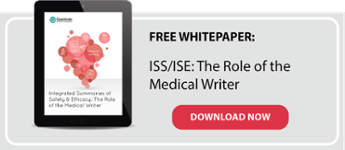Targeted Regulatory Writing Techniques: Clinical Documents for Drugs and Biologics
There are two main areas in medical writing, medical communications and regulatory writing. This blog focuses on regulatory writing, which involves the preparation of clinical study and regulatory submission documentation. Generally, regulatory writers have a PhD in a life science, science-related or medical subject and may be freelance, or employed by sponsors (e.g., pharmaceutical/biotech companies) or clinical research organisations (CROs). Regulatory writers produce a wide variety of clinical documents throughout the life‑cycle of a (potential) treatment, starting with describing and reporting data from clinical trials, through to preparing regulatory submission documents. If the treatment is approved by a regulatory authority, regulatory writers also produce post approval reports on the use of the treatment in patients. Examples of clinical documents produced by regulatory writers most commonly include Investigator Brochures (IBs), Clinical Study Protocols, Clinical Study Reports (CSRs), and the Common Technical Document (CTD). The audience for these documents is usually regularity authorities and ethics committees. The key national regulatory authorities are: Each authority assesses the efficacy and safety of drugs throughout the clinical trials process and ultimately approves the investigative drug/device/compound's use. The importance of preparing high-quality regulatory documents is often under estimated. A CSR is the final result of many months and sometimes years of hard work by study teams, and has to summarise the conduct and results of a clinical study in a clear and unbiased manner. A well-written CSR will aid the subsequent production of high quality submission documents, and conversely, poorly written or presented regulatory documents may lead to delays in regulatory approval, costing the sponsor time and money. In the ever-changing regulatory environment, experienced regulatory writers can add a lot of value to the production of clinical study documentation. As an integral part of the clinical research process, regulatory writers can act as a pool of knowledge at every step, from protocol development to the drug submission process. Regulatory writers are skilled at meeting global regulatory requirements and adhering to guidance documents such as International Conference on Harmonisation (ICH) Good Clinical Practice (GCP), while still fulfilling the needs, preferences and styles of sponsors and/or study teams. They understand, interpret, and summarise often complex scientific and statistical data whilst providing effective guidance to clinical study teams, which usually include experts from other fields such as clinical/medical, statistics, regulatory affairs, pharmacovigilance, and pharmacology. Some regulatory writers become experts in a particular therapeutic area or disease and can provide invaluable insights to the sponsors and/or study teams. Regulatory writers can also perform quality control (QC), peer review and provide other editorial support on documents produced by sponsors and/or study teams, if required. Quanticate offers a wide range of Medical Writing services including clinical and regulatory writing in support of any or all stages of the pharmaceutical development life-cycle. Our Medical Writers deliver accurate, timely and cost effective documents to the highest of ethical and scientific standards. Our team is trusted by top pharma and flexible in our ability to adapt to client systems and standard operating procedures (SOPs). Please submit arequest for information (RFI) if you would like to speak to a member of our team who can support your trial. Related Blog Posts: Authors note: This blog was originally published on 18/03/2011 and has since been updated. 
Importance of Regulatory Writing

Targeted Regulatory Writing Techniques: Clinical Documents for Drugs and Biologics
Source: https://www.quanticate.com/blog/bid/42720/regulatory-writing-an-integral-part-of-clinical-research